
This report describes methods and results of the REDD-PAC project to support decision making on REDD+, biodiversity and land use policies in Brazil. We adapted the global economic model GLOBIOM (developed by IIASA) to analyse land use policies in Brazil and project land change from 2020 to 2050.
Download the report and the summary
The results of GLOBIOM-Brazil are available either as a full report (22 MB, pdf) or as a summary(580 KB, pdf) .
Main message of the report
The overall message of this report is the crucial importance for Brazil of implementing the Forest Code.
To do so, the country faces major challenges.
- A high quality rural environmental cadastre is essential to make sure illegally deforested area in Brazil be restored.
- Brazil needs to set up a monitoring system for the whole country as powerful as the one in place for Amazonia.
- It is crucial to limit the legal reserve amnesty to those who are small farmers, avoiding illicit break-up of large farms.
- The market for environmental quotas needs to be regulated to avoid improper land grabbing and enhance forest conservation.
If Brazil succeeds in applying the Forest Code for its territory, there will be multiple benefits for its citizens, including biodiversity protection, emissions reduction, and institution building.
Model validation
GLOBIOM-Brazil's initial data set is valid for year 2000 and the model projects change on a ten-year period. For validation, we compared the projections for 2010 with official statistics on agricultural production and deforestation.
Differences between IBGE survey data and model projections in 2010 are less than 10%. Deforestation in Amazonia, as measured by INPE, was 16.5 Mha in the period 2001-2010, while the model projects 16.9 Mha of deforestation.
The good validation results give us confidence that GLOBIOM-Brasil can capture the main trends of land use change in the country.
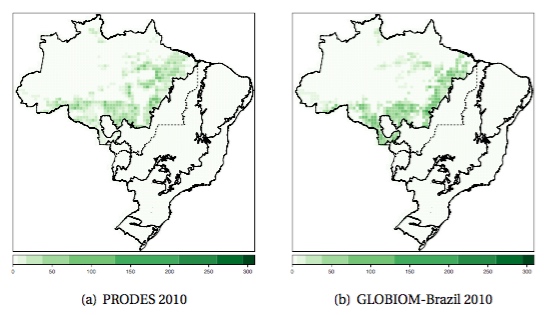
Key results on forest protection
If the Forest Code be enforced, the model projects total forest cover in Brazil to be 430 Mha in 2030 and 425 Mha in 2050. Forest area in Amazonia will stabilise at 328 Mha from 2030 onwards, considering both regrowth and legal cuts of mature forest. In the Cerrado, total forest will level off at 45 Mha.
Forest regrowth in Brazil will reach 10 Mha by 2030. Environmental reserve quotas affect Amazonia and Cerrado more than other biomes and have significant effects on preservation of mature forest and on forest regrowth.
Key results on crop and livestock production
Croplands in Brazil expand in the coming decades in all scenarios, increasing from 56 Mha in 2010 to 92 Mha in 2030 and reaching 114 Mha in 2050. Land area for crop production more than doubles compared to 2010. The figure below shows the maps of projected crop expansion for 2010 and 2030.
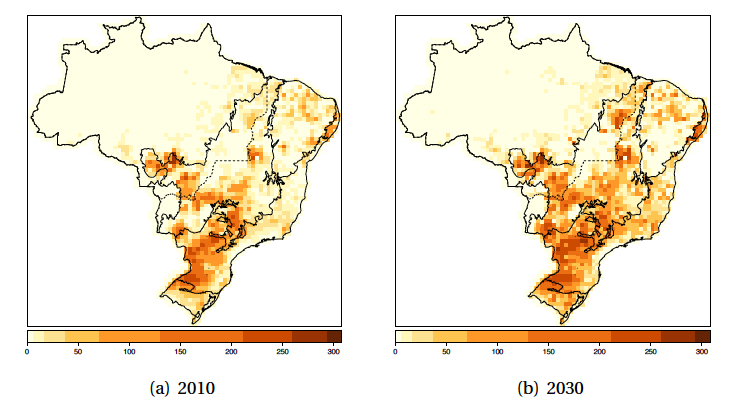
The model projects a significant decrease in pastureland as cattle ranchers improve their practises to increase livestock productivity. Pasture area decreases by 10 Mha in 2030 compared to 2010, with further cuts of 20 Mha by 2050. In 2030, there will be 230 M heads of cattle in Brazil, occupying 30% less area per head than in 2000.
These results point out that environmental regulations (Forest Code and protected areas) do not prevent cropland expansion in Brazil, but allow farmers to produce more food and biofuels.
Key results on biodiversity protection
The main biomes under threat from land use change are the Caatinga and the Cerrado.
The dry forests of the Caatinga are projected to lose 11 Mha from 2010 to 2050. By 2050, over 51% of the natural Caatinga forests identified as important for biodiversity but not protected could be lost. When the loss of both mature forest and natural lands are considered, the Cerrado could lose over 20% of its unprotected areas of biodiversity importance.
Our results show that the Forest Code provides strong protection in Amazonia, but additional measures are needed to increase the protection of the Cerrado and the Caatinga.
Key results on emissions
The Forest Code can bring about a major decrease in greenhouse gas emissions in Brazil. Emissions from deforestation reach 110 MtCO2e (GTP) in 2030, a 92% decrease since 2000. Brazil will bring forest-related emissions to zero after 2030, due to forest regrowth and reduced deforestation.
Increase in pasture productivity will limit the loss of natural land, curbing emissions. Emissions from crop and livestock production reach 160 Mt MtCO2e (GTP) by 2030, most as CH4 from enteric fermentation and manure from cattle.
The Brazilian INDC projects emissions for 2030 of 1.1 Gt MtCO2e (GTP). Emissions from land use and land cover change, including agriculture and forestry, account for 28% of those.
The figure below shows GLOBIOM-Brazil emissions projections for land use change and forests, comparing the Forest Code scenario with a "business as usual" case without enforcement of environmental laws.
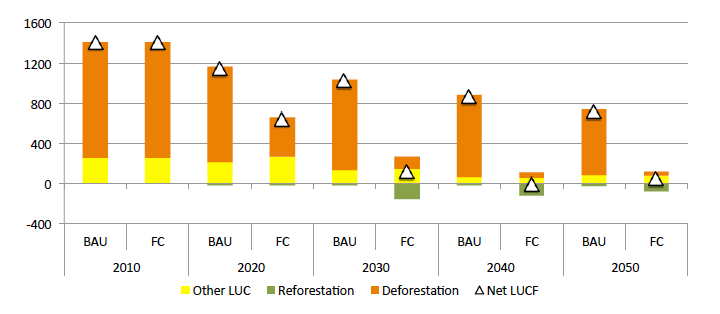

International Institute for Applied Systems Analysis

National Institute for Space Research - Brazil
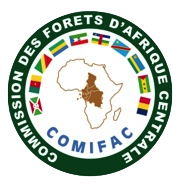
Commission des forets d'Afrique Centrale/Central African Forests Commission

United Nations Environment Programme World Conservation Monitoring Centre

Instituto de Pesquisa Econômica Aplicada
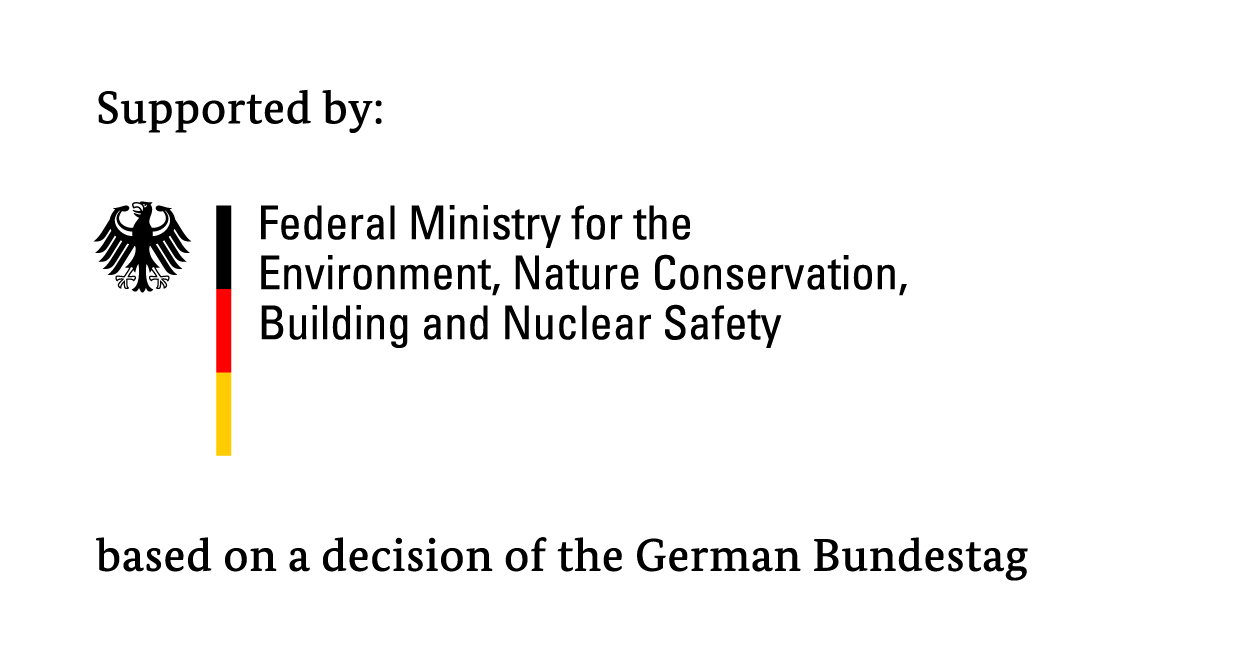
Germany International Climate Initiative
